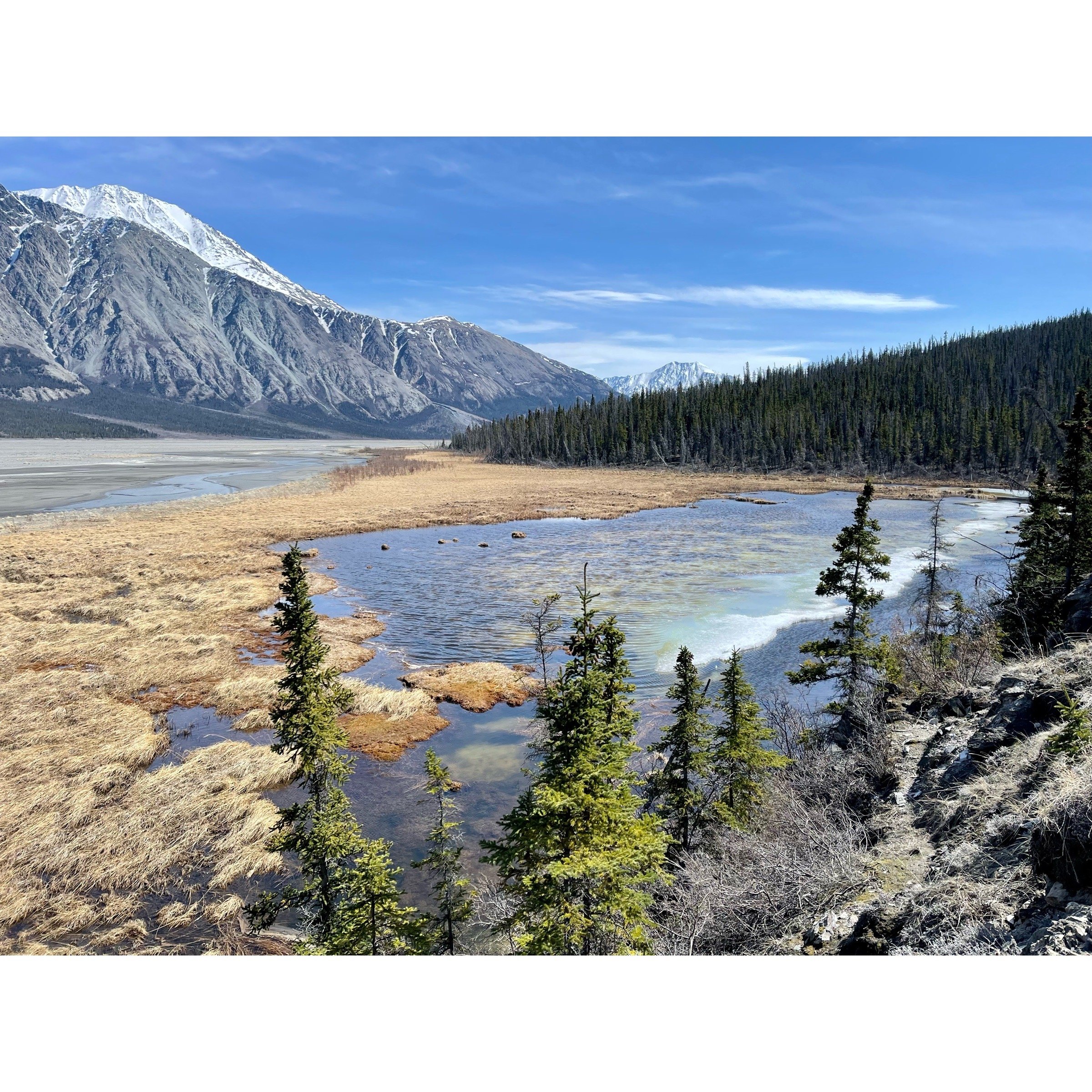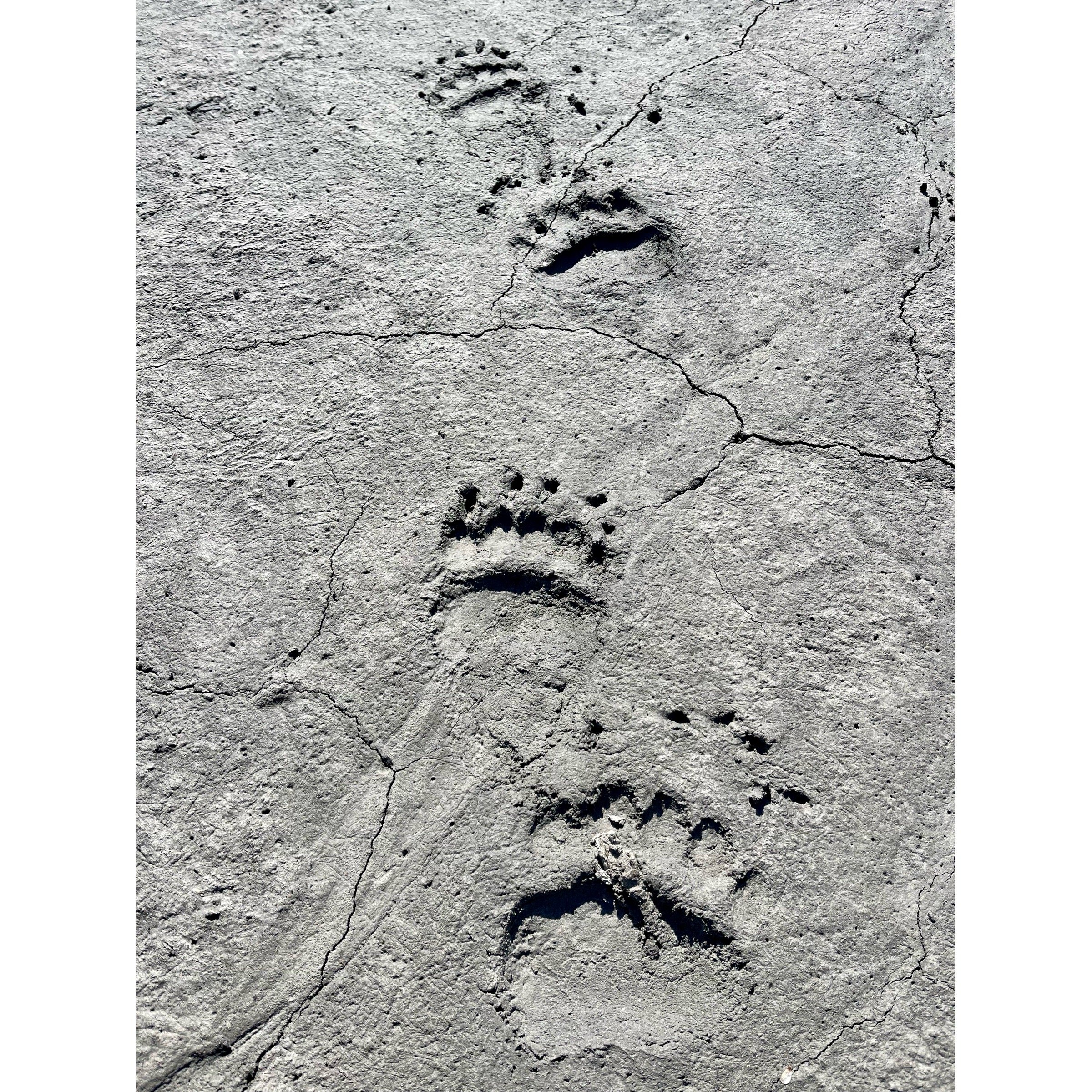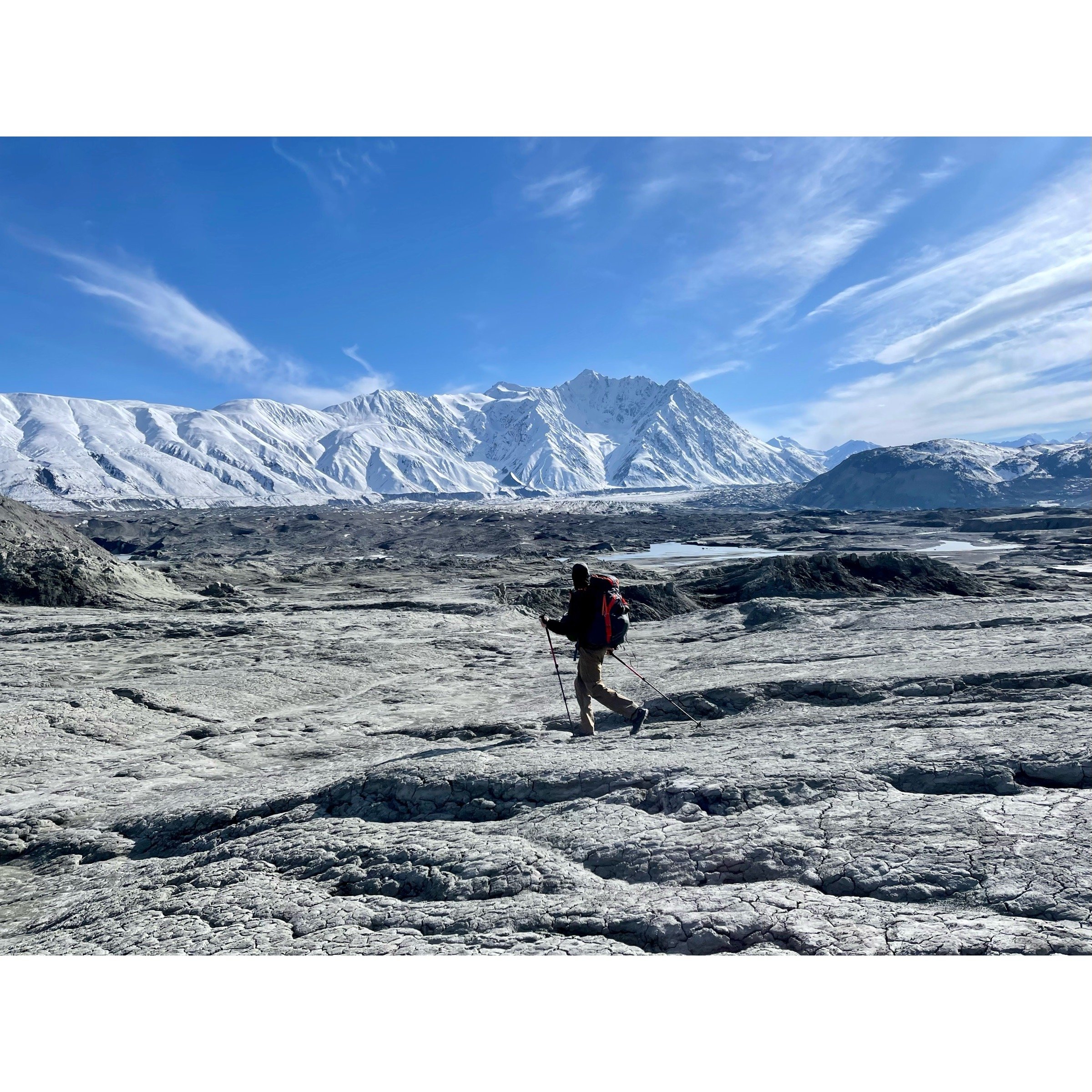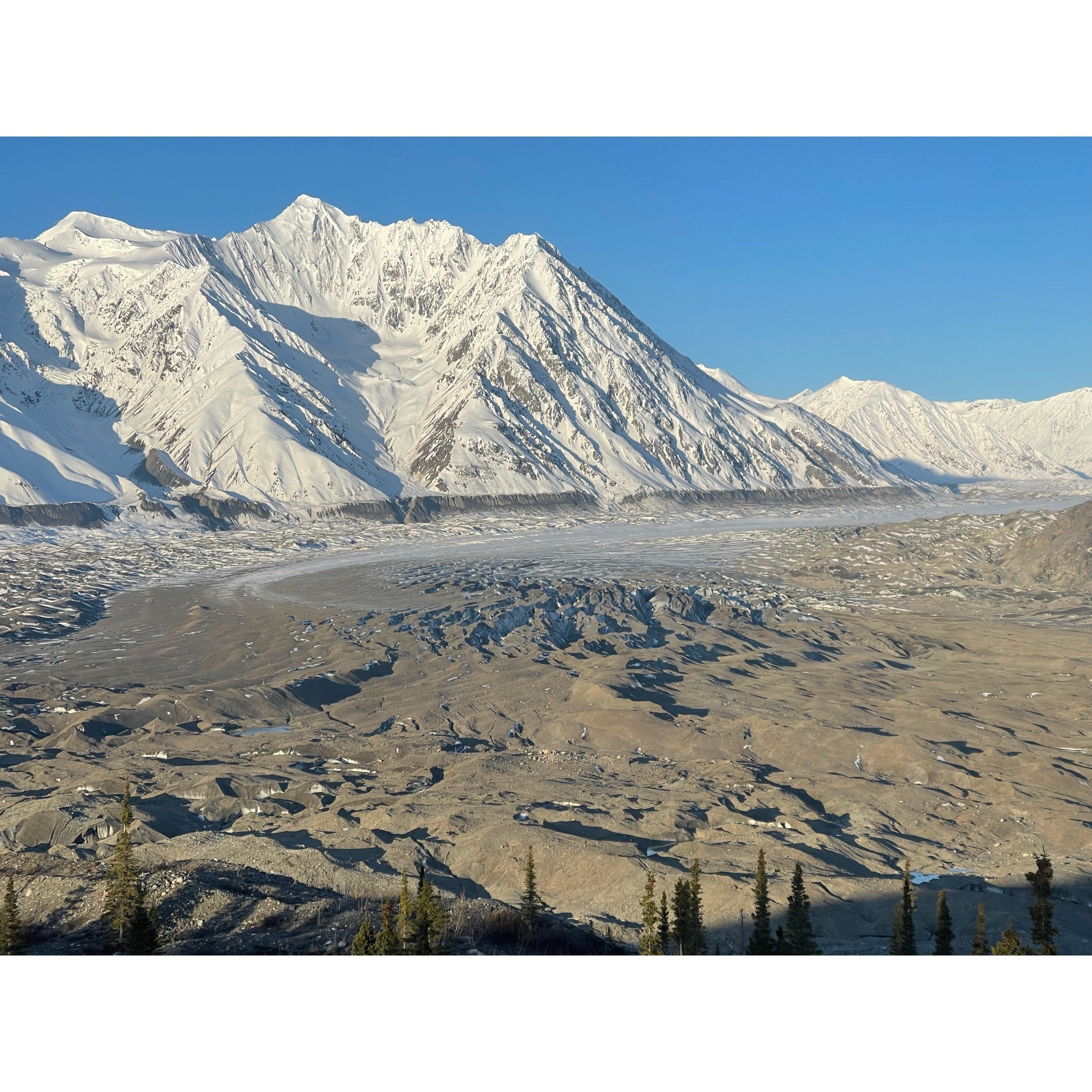Geographies of Grief and Love
A YEAR OF MAGICAL THINKING, TRANSITIONS, AND WRITING THE WILD
A year ago, I stood beneath a twenty-foot long jaw bone belonging to a blue whale killed in Coal Harbour in 1962. Do not ask me what I was doing there, running my fingers down the cold, smooth bone of a species that, half a century ago, the commercial whaling industry had nearly depleted to extinction.
Bad weather, I would’ve told you on that day, referring to the 100-kilometre/hour winds that prevented me from flying 80-km north to my post at a remote floating lodge where I was working as a winter caretaker.
I was relieved to be delayed by the winds. A month earlier, I’d listened to the distress call on the radio from a Cessna-185 float plane that crashed and sank in the inlet south of me, killing the pilot and two passengers, men who worked at a nearby logging camp. I thought of those men all winter. I think of them today.
I RAN MY HAND OVER THE COLD BONE AND COULDN’T DIFFERENTIATE MY GRIEF FOR THE WHALES FROM MY GRIEF FOR THE FALLEN MEN AND MY GRIEF FOR MY BROTHER WHO DIED BY SUICIDE SIX MONTHS EARLIER.
Jaw bone of a blue whale killed in 1962 in Coal Harbour. (Photo: Trina Moyles)
Coal Harbour operated a whaling station from 1948 to 1967. (Photo: Trina Moyles)
Grief can PULL a person down into unfamiliar geography. GRIEF CAN REARRANGE WHAT WE THINK WE KNOW ABOUT THE WORLD.
I chose to grieve my brother by spending a winter alone on the water. After he’d died, I felt a strange propulsion to be near the water. I can’t tell you why, but I longed to immerse my body in water right up to my eyelids. Somewhat serendipitously, the invitation to work as a winter caretaker on a floating eco-lodge on the central coast came at the tail end of my fire tower season. I’d just worked five months alone. But I wasn’t sure what else to do, and the opportunity to work on a book manuscript about black bears in the Great Bear Rainforest felt too good to be true.
Maybe being alone felt safer to me than learning how to integrate my grief in society. I wanted to make sense of my brother’s story without having to manage the way I spoke about suicide (the very word, “suicide”, fires off like a shotgun) and how it would impact others. Grieving a loved one lost to suicide is a layered experience that can evoke sorrow, anger, resentment, confusion, guilt. My brother’s death was so devastatingly sudden that a part of me still couldn’t believe it to be true.
I related to what Joan Didion wrote in The Year of Magical Thinking, a memoir about the year following her husband’s death, “…there was a level on which I believed that what had happened remained reversible. That was why I needed to be alone.” Like Didion, I consciously engaged in this “magical thinking” as a means to try to bring him back.
I wrote my brother into the pages of a book about growing up in northern Alberta and learning to coexist with black bears. I saw him in the wider story of the black bear, a smaller, lesser valued species of bear. It felt like I was writing a grief narrative, but an editor friend who read the manuscript told me, “your brother is alive in these pages.”
Is it possible to bring someone you love back from the dead?
Humpback whales frequented the inlet into late December. They surfaced daily, their dorsal fins sluicing through the water, rising up like mountain peaks. I loved the mystery of the whales, that I could only see a part of them. Humpback whales can grow the same length as a school bus. The sound of their exhales called me down to the dock to watch them diving and surfacing in seven to ten minute intervals.
Humpback whale surfacing near the dock of the Great Bear Lodge in late October. (Photo: Trina Moyles)
As the weeks passed, I grew emotionally attached to the whales, to the act of listening and watching for them. I felt as though they were breathing for me. I’d been holding my breath since the day my brother died.
Inevitably, the whales left mid-December, abandoning the inlet for their breeding waters in Hawaii. The males had love songs to orchestrate and perfect, as they crossed the ocean, trying to avoid being struck by cargo ships.
Since the commercial whale hunt in Canada was banned in 1986, a year after I was born, the number of humpback whales in B.C.’s waters has significantly increased.
In the context of mass species loss, the resurgence of humpback whales is a rare success story, a species brought back from the near dead.
After the whales had departed, I surfaced from the pages of my book manuscript, sending it off to my publisher for their final decision (yay/nay) — and I found myself very much alone.
Until then, I’d thought that I’d perfected the art of being alone. I’d worked seven years as a fire tower lookout. I felt as though I could psychologically withstand any hardship in isolation. My friends often sent me far-flung job postings: a position as a post-office worker in Antarctica, a migratory bird counter on a remote island off the U.K.
My professional niche had become “living in isolation”, but I WAS NO LONGER sure if that was something to be proud of.
This was one of the ways in which my brother and I — similar on many fronts — were markedly different. My brother always had people around him. As a child, he played on a hockey team and relished in big social gatherings. I could get lost alone for hours, wandering the muddy riverbanks, or sinking into the pages of a novel. My brother was the first to become a parent, raise children, build a home. I’d done the opposite: devoting my time to distant places, to the solitary nature of writing books, a transient lifestyle. I found myself questioning everything.
WHAT DID he KNOW THAT I DIDN’T?
Sisters and brothers are a reflection of our own selves, genetically the same, but often behaviourally different. This differentiation, psychologists say, is an unconscious strategy for competing for limited resources of parental care. My brother was my only sibling, a living link to the childhood we shared, the most formative years of my life. How could he be gone? How could he have left us? And who would I be without him? I couldn’t imagine the future without him.
Winter struck the coast like a fist. Winds from the interior came screaming down the inlet, blowing into the poorly insulated staff quarters. I huddled around the propane stove and piled five quilts on top of me at night. The water pipes long drained, there was no running water, or the comfort of a hot shower. I shit in a 5-gallon bucket. The snow fell in heavy, fat flakes, obscuring my view and nearly sinking a boat tied up to the dock. I was weary of being physically alone against extreme elements. The loss of my brother ached like a phantom limb.
By late February, nearly ten months after my brother’s death, I couldn’t stand the isolation any longer. That I had nearly spent a decade alone terrified me. It had begun to feel a little too self-sacrificial. Like I was avoiding the complexity of human relationships. Like I was missing out on something essential to life.
Though it pained me, I wrote an email to my supervisor that, come spring, I would not be returning to the fire tower. I felt a mix of relief, excitement, and trepidation for the inevitable: what next? Where?
In early March, the bad weather broke, as it always does. It was a relief to see the sky and mountains again. It felt like a second chance at life. I thought about that often last winter: what it means to get the opportunity to live again. Something my brother wouldn’t be able to do, but maybe I could do for us both.
I paddled the Nekite estuary and felt alive on the sparkling waters. Spring wasn’t so far away. I imagined the bears stirring in their dens. Living alone in the Great Bear Rainforest, being in the company of whales, seals, otters, cougars, and wolves, was an enormous privilege. I’m not sure if I’ll ever get the chance to live on the water again. On my last day at the lodge, a group of Elders from the Gwa’sala First Nation landed in a float plane in the inlet and docked at the lodge. They were touring their traditional territories. I felt immense relief to be in their company. A woman told me about a nearby lake, the source of one of their creation stories. I didn’t want them to go.
that winter of grieF surfaced a desire within, a longing to put down roots in a place, a longing to not have to hack it so alone.
I wasn’t sure what my life was going to look like, but my brother’s death taught me that I needed more balance between solitude and community. We aren’t meant to go through hard things alone.
In mid-March, the day after I wrapped up my contract and the dogs and I had flown back to Vancouver Island, I received an email in the marina parking lot in Port McNeill. Black Bear had been accepted for publication at Knopf, a Canadian publishing house I’d long admired. It was surreal getting the news that this thing I’d been working on for years, pouring energy into without any trace of certainty, was going to become a book I could share with the world.
How badly I wanted to text my brother with the good news. How proud he would have been.
i HAD TO DECIDE WHERE TO GO, WHAT TO DO, and so I looked north.
As an adult, I’d always followed Highway 35 north to my childhood home, my home-base, in the Peace Country of northern Alberta. But my parents had sold our little grey house in order to finish the home my brother had been building for his family and honour his vision — and what a beautiful home it is today. Even so, this broke my heart a little, to say goodbye to a childhood home. Another heartstring severed. I wasn’t sure where “home” was anymore.
In April, I emptied out my storage locker in Peace River into a U-Haul and my dad and I caravanned north along the Alaska Highway to a cabin in Carcross, Yukon. I decided to move to the Yukon knowing it’s a place where I could be outnumbered by trees and feel small against the wilderness, but also where I would hopefully meet others drawn to the same landscapes. I also longed for a community with whom I could share in the process of making art.
“Give it one year,” my mom advised me. “Try to be in the same place for a year and then reassess.” IT OCCURRED TO ME THAT i HADN’T REALLY PUT DOWN ROOTS IN OVER A DECADE. A YEAR WOULDN’T BE HARD — WOULD IT?
The first few weeks in the Yukon were strange for me, witnessing the signs of snow melt and green-up, and yet not having a tower to climb, or a horizon to scan for wildfire smoke. Instead, I half-heartedly scanned online for jobs. I wasn’t sure what I wanted to do. “Am I even employable after seven years of working in the bush?” I half-joked to friends.
I was privileged to be able to draw from my savings to give myself a few months to get back on my feet again.
Spring transitions. The long thaw on Bennett Lake in Carcross, YT.
Spring transitions. The return of trumpeter swans to their breeding grounds in the north. (Photo: Trina Moyles)
Spring transitions. New antler growth on a bull moose along the highway to Haines Junction. (Photo: Trina Moyles)
Spring transitions. A white-winged crossbill feeding on spruce cones outside my cabin in Carcross, YT. (Photo: Trina Moyles)
In late April, as the snow slowly evaporated from the valley floors and mountain slopes, I spent hours exploring the sandy trails around my cabin in Carcross. I wove through the pine forest, stumbled upon fresh bear tracks in the snow melt and watched the ice gradually retreat on Bennett Lake.
A friend and I hiked on the weekends, despite the enduring snow. We bonded over the effects of climbing mountains, the way it can physically hurt and psychologically humble a person. We were both grappling with recent losses of different kinds. Hiking was a kind of moving meditation for us both, I think, a shared trajectory offering epic views and high-calorie snacks and moments of hilarity.
In early May, we hiked a 60-kilometre loop along the A’ay Chu River to the Kaskawulsh Glacier in Kluane National Park, over two short days. It was an intense physical push to keep up with my six-foot-something friend, built like a thoroughbred racer, but the hike was exhilarating and made me feel incredibly alive.
We were the only humans in the valley, sharing the trail with grizzly bears and wolves whom we never saw. We camped near the terminus of the glacier, trying to find a sheltered place out of the winds which blew violent dust storms through the valley. While we shovelled noodles into our mouths, a lynx emerged from the tree line.
In the morning, we scrambled up a mountain to watch the sunrise on the glacier. We didn’t talk much. I hadn’t slept well due to the long light and my feet ached. We sat and dangled our feet off the edge and ate granola bars.
The Kaskawulsh Glacier has receded more than a mile over the past century. The glacier terminates at the head of two different river systems, the A’ay Chu River, the southern Tutchone name for Slims River, (which feeds Kluane Lake and the Yukon River) and the Kaskawulsh River (which feeds the Alsek River).
In the spring of 2017, scientists documented a rare geologic event called “river piracy”. The toe of ice that feeds the A’ay Chu River retreated so far back that the meltwater changed course. Instead of flowing into the A’ay Chu River, the meltwater changed course and joined the Kaskawulsh River, which flows south into the Gulf of Alaska.
The geologic event has redrawn the landscape. While the Kaskawulsh River is surging with increased water, the A’ay Chu River is slowing disappearing. One river will die and the other will live on. As a result, the water levels in Kluane Lake are rapidly dropping, which will have future impacts on the Yukon River, as well.
My friend called it “a dying glacier”. I gazed down at the glacier and the A’ay Chu riverbed: bone dry.
I thought of my brother’s life as a river. How his death had radically altered the flow of our family’s life. Suicide is another kind of piracy. A life stolen, far too early. Suicide is one of the leading causes of death of middle-aged men in Canada. In Alberta, the rate is 35 percent higher than the national average. These abrupt changes are difficult to reconcile, but they deserve our care and attention. They ask of us: please don’t look away.
I didn’t tell my friend that I carried my brother’s ashes in my backpack. It didn’t seem necessary. He was carrying his own losses. Grief is the act of carrying the dead while simutaneously trying to be alive — to be fully present — in the world.
But grief is really just an expression of love. A lament for the people and places that we love, that hold sacred value, that make us who we are.
I can’t bring my brother back, but I can go on living for the both of us, carving out space to hold the pain and beauty that is the human experience — and loving this world, fully, unapologetically, despite it all.
Overlooking the terminus of the Kaskawulsh Glacier in the A’ay Chu river valley at sunrise.
If you enjoyed reading this article, please consider “buying me a coffee” to help support my work as a writer.














